CLICK Refresh FOR SLIDES
Grand old gardens seem to assert the outer borders of Nantes in each direction but it is to the North that is located a roseraie for all seasons with ample flowering year round, baroque roses in the warmer months aside hardy new roses which still flower in the cold months. The old roses are deceptive, not to be judged quickly, for what comes coupled with the higher vulnerability is an aspect that ultimately adds to their mystique and appeal.
The rose garden has 20,000 rosebushes, representing nearly 1600 varieties. Inaugurated in June 1988, it is distinguished from its elders, such as Bagatelle in Paris and the Tête d’Or in Lyon, with an original design combining shrubs and perennials. The choice to associate perennials with roses has been made since its creation. The idea was to multiply the shrub layers and the flowers and thus to emphasize the roses even more. An association that quickly made sense when the rose garden was managed organically. As early as 1995, the service worked on an integrated biological protection principle (PBI). From a perennial herb dosage, the PBI can attract auxiliary insects that will rid the roses of aphids and avoid chemical treatment.
CLICK Refresh FOR SLIDES
Google Maps – Parc Floral Roseraie
During my first Summer I experienced France in some of its finest moments, the long sweeping shadows of the Chantrerie defining the late afternoon, small sparkling flower heads leaning in as we lunched alone on the rear manor house steps, oblivious to the activity the statues behind us had seen in centuries past.
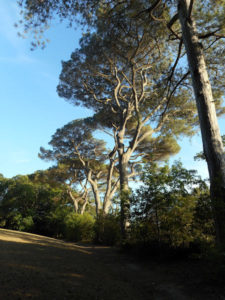
History
Built on the banks of the Erdre, running for almost 900 meters, this 18 hectare park was once part of an estate belonging to the Nantes cathedral on the eve of the Revolution. There was an important farm where the incomes essentially derived from the cultivation of the vineyard (planted at the beginning of the 17th century), were used to maintain the cathedral choir, which explains the name – “Chantrerie” comes from the word chantre, to sing.
In 1697, Miss Jean Barrin, “singer in dignity of the cathedral church of Nantes”, rented out the house, lands and dependencies of La Chantrerie for a period of nine years to Marie Bernardeau, widow of Pierre Niel, originally from Carquefou. The farmhouse then comprised the main house, the press, the stable, the garden, meadows, arable land, woods, coppice, vineyards, and a right to fish on the Erdre.
Before the Revolution, the family Launey, a farming family occupied the estate paying 900 livres a year. Becoming a national property, Les Launay bought it in 1791 for the sum of 60,200 livres. Forty years later, the estate was owned by the Nantes architect Étienne Blon who built the present villa there in 1825. In 1831 his daughter Anne-Clemence married Louis Levesque, son of the mayor of Nantes Louis-Hyacinthe Levesque. The latter had the chapel erected in 1836 and in 1860 the house of his father-in-law was enlarged to give it a floor. In 1872 the landscapist Nantes’ Dominique Noisette who is also responsible for the development of the Parc de Procé was responsible for redesigning the park.
La Chantrerie remained in the hands of the Levesque family until 1922. In 1938 the owner Similien Normand sold it to the Drouins, a former family of ship owners later involved in road transport. The latter sold it to the city of Nantes in 1972. At the time of the acquisition it was 37 hectares in area with one half converted into a public park, the “Chantrerie Park” as we know it which was opened to the public in 1979, and the other half hosting the same year the buildings of the National Veterinary School of Nantes.
The villa, the surrounding pavilions, the orangery, part of the park and the chapel are listed in the supplementary inventory of historic monuments by decree of 20 May 1973.
The Parc de la Chantrerie has given its name to the Campus de la Chantrerie located nearby.
CLICK Refresh FOR SLIDES
« Nantes : peut-être avec Paris la seule ville de France où j’ai l’impression que peut m’arriver quelque chose qui en vaut la peine … où un esprit d’aventure au-delà de toutes les aventures habite encore certains êtres, Nantes, d’où peuvent encore me venir des amis, Nantes où j’ai aimé un parc : le parc de Procé. » André Breton, 1928
“Nantes: perhaps with Paris the only city in France where I have the impression that something worthwhile can happen to me … where for me the pace of life is not the same as elsewhere, where a spirit of adventure beyond all adventures still lives in some people, Nantes, where friends can still come to me, Nantes where I liked a park: Procé Park. ” André Breton, 1928
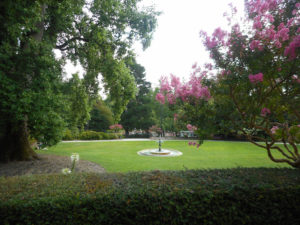
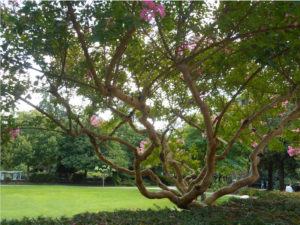
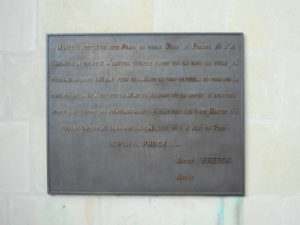
Parc de Procé has been appreciated by many people including Andre Breton, quoted on a plaque outside on the terrace café wall. Like most gardens in France they are entered by tall wrought iron gates and a café is housed in the old manor. Time doesn’t matter as we eat gelato and chat on the terrace looking down on the front park and fountain through the gnarled branches of the very old and well pruned crepe murtle trees. Pruning is an art form in France where ever it occurs and I imagine taken for granted a little by the French, but to me the shapes are a key to recalling and respecting formalities of times past. A large Dahlia collection is secreted far away in the top corner of the gardens and comes as a surprise like many things. The species are all labelled and can be easily perused from markers along the stone mosaic paths. A traditional rotunda, mint green sits playfully among the flowers.
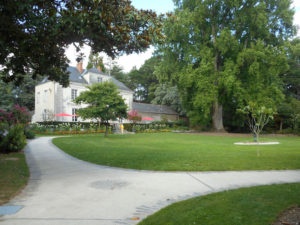
Most of Procé’s (Wikipedia) park occupies the northern slopes of the Chézine valley, a tributary of the Loire . The river enters the park in the south-west under the Jules-César bridge and travels 200 metres south-east, feeding two small ponds before passing under the street of Dervallières; The space is mainly covered with lawns accessible to visitors, making it a popular place to walk.
The park’s manor house was built in the late 18th century. It was rebuilt around 1830 by Marion de Procé, owner and mayor of Saint-Père-en-Retz. His heirs later sold it to Gustave Caillé, a shipowner and wood merchant. The latter completely reorganized the park in 1866 according to the plans of the landscape architect Dominique Noisette (nephew of Louis Claude Noisette) and gives it its current appearance. His children, the poet, scholar and lawyer from Nantes Dominique Caillé, priest Charles Caillé and Arthur Écomard and wife of the mayor of Carquefou, sell the park to the city of Nantes in 1912 then led by Paul Bellamy, close friend of Arthur Écomard, at a symbolic price of 320,000 francs in order that it could be preserved. For the city of Nantes, this completed to the west of the city a set of large public green spaces.
During the First World War, part of the estate’s land was used by the town hall to remedy the food shortage. Plots were planted with potatoes and this operation, also carried out in the park of Grand-Blottereau , was successful due to the employment of German prisoners of war with the harvest reaching 137 tons. Moreover, facilities made available to sports companies were set up in the upper part of the park and the stage of Procé was inaugurated on May 4, 1919. They are supplemented by tribunes, inaugurated in 1936 and a track for athletics was created after the Second World War.
In 1929, the municipality planned to transform the part of the Chézine valley downstream of the park into a vast promenade leading to the Canclaux square. Most of the expropriations were implemented but the project was abandoned as a result of the change of the municipal team. However, from 1941, towards the south-east towards the place Paul-Doumer, a part of the acquired grounds made it possible to build a school stage and a garden for children (current kindergarten of the park of Procé ). The latter later receives the basin which was previously in the center of the Place Duchesse-Anne and hosted the statuary ” Bathers “, moved in the late 1920s during the work of diverting the Erdre.
In 1941, the municipality led by Auguste Pageot acquired four statues from the Palais du Trocadero in Paris, demolished in 1935 to make way for the Palais de Chaillot . They are installed in the upper part of the park. At the same time, the three sculptures are received and erected near the bridge Jules-Cesar, vestiges of the old municipal fishmonger. The building originally had four statues but the last one, representing the Erdre or Boulogne, disappeared during its demolition.
In 1995, Procé Park received its kiosk from the old Piou salons, after restoration. It’s a kiosk whose life was hectic. Built in the park of Château du Vivier in Saint-Joseph de Porterie, it joined in 1936 the district of Batignoles after the destruction of the castle. For 50 years it was the emblem of the Piou fairs (now Boulevard Jules-Verne), a community meeting place.
CLICK Refresh FOR SLIDES
In this wooded park, chestnut trees and centuries-old oaks rub shoulders with the exotic trees introduced in the 19th century. The park is also an exotic mountain walk in the hollow of the shady valley of the Patouillerie.
Former property of a Chaurand family the landscape design of this site dates back to the nineteenth century. It was remodeled in its upper part in the 1990s. Today, it reflects an image of the mountain and exudes such a natural atmosphere that exotic trees present, bald cypress, Douglas fir, redwoods, red oaks of America all appear to belong to the native flora.
The 30 000 bulbous plants scattered in the lawns offer a spring show at the end of March, extended by the flowering rhododendrons (collection of 1500 plants in 110 varieties) and that of perennials. In the hollow of the shaded valley, in the alpine rock sit Narcissus bulbs, crocuses and anemones. They are today the original signature of this par
CLICK Refresh FOR SLIDES
Google Maps – Parc de La Gaudinière
I won’t ever forget the exhilaration during my first Summer in France as I discovered the manor and its Japanese garden reached via a park which shared an overgrown boundary with the rear of our garden. I came to it unexpectedly under the huge Japanese elm at the end of three kilometers of cow paddocks and shady riverbank paths, somewhere between lazy suburbia and heaven. The soft shadows of the glades give way to remnants of an industrial past. We sat and ate cake from an old painted cake tin and I knew there and then, I was in France.
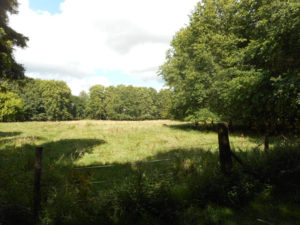
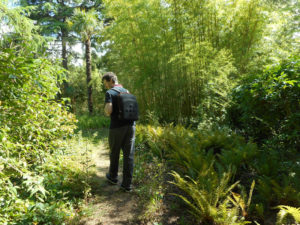
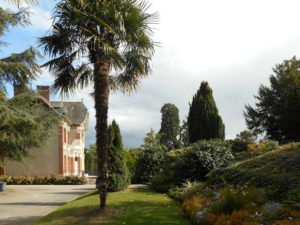
History
In 1972 Rezé City bought the Morinière Park, in order to preserve the green areas. Today, it is the second historic park of Rezé.
In the park of Morinière on the edge of the Sèvre, the brick chimney testifies to the industrial past of the site- powder deposit, fertilizer factory, palm oil production in the eighteenth century. Industrial plants follow one another on the site of Morinière. With the Sèvre two steps away and Port Morinière, now Léon-Sécher wharf, the transportation of industrial products by boat was easy.
In the middle of the 19th century the site was purchased by Henri Suzer who transformed Morinière tannery and the factory manufactured gaiters for the army. The war of 1870 signified a golden age of the tannery and the factory thrived employing nearly a thousand people on two sites, Morinière and the Isle of Versailles. Henri Suzer took the opportunity to build the manor, which he called “Le petit Choisy sur Sèvre”.
At the death of Henri Suzer, his son took responsibility for the factory but activity was slow and the factory was sold in 1894. The Society of Chemicals, Nantes took over with its manufacture of “blues” used to treat gold ores and in 1905 an explosion discharged toxic waste into the Sèvre, which colored the rock in blue, hence the name, the blue path. After the First World War, the factory no longer was in operation but the manor remained inhabited.
In 1972, the city bought four hectares of the site, the manor and the buildings for 800 000 F. If the manor was in a good state, the industrial buildings were dilapidated. The chimney stamped “SN” sits in the middle of the plants. It is not so much the manor as the ground which interests Rezé. At the time, the only park in the town was the Carterie, in the district Pont-Rousseau. It was therefore a policy of preservation of green areas and development of relaxation areas that pushed the city to acquire the Morinière.
The land was converted into a park, the old tannery into a reception center for foreign delegations and the manor ground floor used as an exhibition space in the Summer months.
CLICK Refresh FOR SLIDES
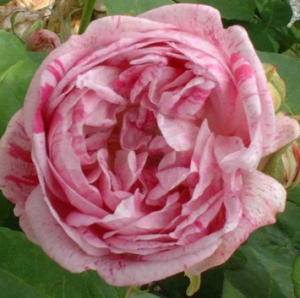
Grand old gardens seem to assert the outer borders of Nantes in each direction but it is to the North that is located a roseraie for all seasons with ample flowering year round, baroque old roses in the warmer months aside hardy new roses which still flower in the cold months. One could live in Nantes for this garden alone.
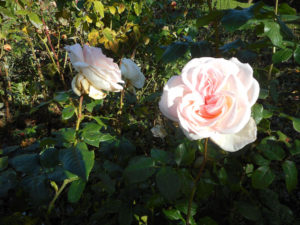
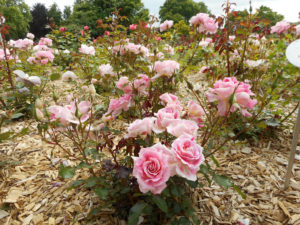
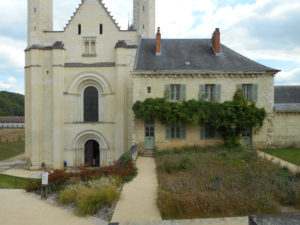
The Royal Abbey of Our Lady of Fontevraud or Fontevrault (in French: abbaye de Fontevraud) was a monastery in the village of Fontevraud-l’Abbaye, near Chinon, in Anjou, France. It was founded in 1101 by the itinerant preacher Robert of Arbrissel. The foundation flourished and became the center of a new monastic Order, the Order of Fontevrault. This order was composed of double monasteries, in which the community consisted of both men and women—in separate quarters of the abbey—all of which were subject to the authority of the Abbess of Fontevraud. The Abbey of Fontevraud itself consisted of four separate communities, all completely managed by the same abbess.
The first permanent structures were built between 1110 and 1119.[1] The area where the Abbey is located was then part of what is sometimes referred to as the Angevin Empire. The King of England, Henry II, his wife, Eleanor of Aquitaine, and son, King Richard the Lionheart were all buried here at the end of the 12th century. It was disestablished as a monastery during the French Revolution.
A UNESCO World Heritage Site, it is situated in the Loire Valley between Chalonnes-sur-Loire and Sully-sur-Loire within the Loire-Anjou-Touraine French regional natural park (Parc naturel régional Loire-Anjou-Touraine).
The complex of monastic buildings served as a prison from 1804 to 1963. Since 1975, it has hosted a cultural centre, the Centre Culturel de l’Ouest.
CLICK Refresh FOR SLIDES
CLICK Refresh FOR SLIDES